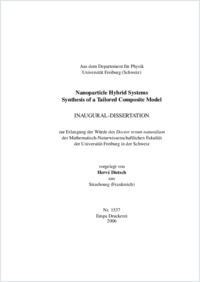Nanoparticle hybrid systems synthesis of a tailored composite model
- Dietsch, Hervé
- Schurtenberger, Peter (Degree supervisor)
-
09.10.2006
130 p
Thèse de doctorat: Université de Fribourg, 2006
English
French
German
Spherical and monodisperse SiO2 silica colloidal particles in a range of 30 nm to 1 μm are prepared using sol-gel processes. Their surfaces are functionalized with silane agent allowing covalent bond formation or not with macromolecules chains of a crosslinked elastomer (PMMA or PAA), polymerized under UV light. In order to track particle under shear, there is a need to produce fluorescent particle. As commercial organic dyes (FITC, RITC) show photo bleaching, our motivation to get stable fluorescent particle under UV excitation leads to a new synthesis for CdSe quantum dots at low temperatures. This approach allows the synthesis at large scale and low costs of fluorescent particles emitting from yellow to red. Incorporation of these quantum dots, avoiding any loss in the fluorescence emission and using another silane agent, the 3-propyl trimethoxymercapto silane is also described. An in-situ study and characterization of the nanocomposite is performed using tribology, rheology, 3-DLS and SANS techniques. After proving that agglomeration and/or aggregation are avoided in our process (3-DLS, SANS), mechanical (tribology, rheology) and thermal (DSC, ATG) studies showed the effect of the ratio VNP/SS.Ø with VNP, volume of a single particle, SS, specific surface of a particle and Ø, the volume fraction of incorporated particles, on the friction coefficient, and the glass temperature.
Des colloïdes de silice sphériques et monodisperses sont préparés par voie sol-gel avec des diamètres compris entre 30 nm et 1 μm. Leur surface est fonctionnalisée par différents silanes permettant des liaisons covalentes ou non avec les chaînes d’un réseau élastomère (PMMA ou PAA), polymérisés in-situ sous lampe UV. Afin de suivre la trajectoire de particules sous cisaillement, il est nécessaire de les rendre fluorescentes. Les marqueurs fluorescents organiques (FITC, RITC) photoblanchissent, notre motivation pour obtenir des particules fluorescentes stables a mené à une nouvelle synthèse pour l’obtention de CdSe quantum dots, à basse température. Cette approche permet la synthèse à grande échelle et à faible coût de particules fluorescente émettant du jaune au rouge. L’incorporation de ces quantum dots évitant tout problème de baisse de l’émission et utilisant un autre agent silane, le 3-propyltrimethoxymercapto silane est également décrite. L’étude in-situ et la caractérisation du nanocomposite obtenu est effectuée utilisant les instruments de tribologie, rhéologie, 3-DLS et SANS. Après preuve faite que toute agglomération et/ou agrégation est évitée dans notre procédé (3-DLS, SANS), des études mécaniques (tribologie, rhéologie) et thermiques (DSC, TGA) ont montrés l’effet du ratio VNP/SS.Ø avec VNP, le volume d’une particule, SS, la surface spécifique d’une particule et Ø, la fraction volumique de particules incorporées, sur le coefficient de friction et la température de transition vitreuse.
Spherische und uniform dispergierte SiO2 Silica-Partikel werden durch eine Sol-Gel Synthese mit Durchmesser zwischen 30 nm und 1 μm hergestellt. Die Oberfläche wurde durch verschiedenen Silane funktionalisiert. Die Silane ermöglichen sowohl eine kovalente Bindung an die Polymerketten (PMMA oder PAA), von welches polymerisiert unter einer UV Lampe, als auch eine nicht kovalente Bindung. Um die Partikel unter dem Einfluss von Scherkräften folgen zu können, braucht man fluoreszierende Partikel. Die fluoreszierenden organischen ”dyes” (FITC, RITC) ”photobleachen”, unsere Motivation um stabile fluoreszierende Partikel zu haben, hat zu einer neuen CdSe Quantum Dot Synthese mit niedrigen Temperaturen geführt. Diese erlaubt die Synthese von einer grösseren Menge mit geringen Kosten von fluoreszierenden Partikeln, die zwischen gelb und rot emittieren. Die Einbettung von diesen Quantum Dot ohne Rückgang der Fluoreszenz auf der Oberfläche von den Silica-Partikeln ist auch beschrieben. Dafür braucht man ein anderes Silan: das 3-Propyltrimethoxymercapto Silane. Die in-situ Studie und die Nanokomposite Charakterisierung ist mit Tribologie, Rheologie, 3-DLS und SANS durchgeführt. Nach dem Beweis, dass Agglomerierung und/oder Aggregierung in unserem Prozess vermieden ist, zeigen mechanische (Tribologie, Rheologie) und thermische (DSC, ATG) Untersuchungen den Einfluss von der Ratio VNP/SS.Ø mit VNP , Volumen einem Partikel, SS, die spezifische Oberfläche von einem einzelnen Partikel und Ø, den Volumenanteil von eingebetteten Partikeln auf den Reibungskoeffizient und die Glastemperatur.
- Faculty
- Faculté des sciences et de médecine
- Department
- Département de Physique
- Language
-
- English
- Classification
- Physics
- License
-
License undefined
- Identifiers
-
- RERO DOC 7949
- URN urn:nbn:ch:rero-002-101078
- RERO R004400832
- Persistent URL
- https://folia.unifr.ch/unifr/documents/300380
Statistics
Document views: 249
File downloads:
- Texte intégral: 219
